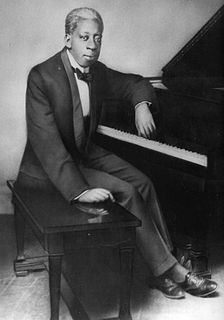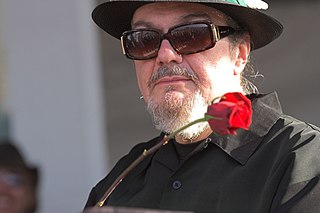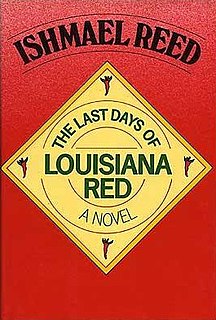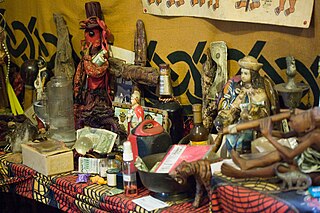Related Research Articles
Mojo, in the African-American spiritual practice called Hoodoo, is an amulet consisting of a flannel bag containing one or more magical items. It is a "prayer in a bag", or a spell that can be carried with or on the host's body. Alternative American names for the mojo bag include gris-gris bag, hand, mojo hand, conjure hand, lucky hand, conjure bag, trick bag, root bag, toby and jomo. The making of mojo bags in Hoodoo is a system of African-American occult magic. The creation of mojo bags is an esoteric system that involves sometimes housing spirits inside of bags for either protection, healing, harm and to consult with spirits. Other times mojo bags are created to manifest results in a person's life such as good-luck, money or love.

Storyville was the red-light district of New Orleans, Louisiana, from 1897 to 1917. It was established by municipal ordinance under the New Orleans City Council, to regulate prostitution. Sidney Story, a city alderman, wrote guidelines and legislation to control prostitution within the city. The ordinance designated an area of the city in which prostitution, although still nominally illegal, was tolerated or regulated. The area was originally referred to as "The District", but its nickname, "Storyville", soon caught on, much to the chagrin of Alderman Story. It was bound by the streets of North Robertson, Iberville, Basin, and St. Louis Streets. It was located by a train station, making it a popular destination for travelers throughout the city, and became a centralized attraction in the heart of New Orleans. Only a few of its remnants are now visible. The neighborhood lies in Faubourg Tremé and the majority of the land was repurposed for public housing. It is well known for being the home of jazz musicians, most notably Louis Armstrong as a minor.

Antonio Junius "Tony" Jackson was an American pianist, singer, and composer.

Hoodoo is a set of spiritual practices, traditions, and beliefs which were created and concealed from slaveholders by enslaved Africans in North America. Hoodoo evolved from various traditional African religions and practices, and in the American South, incorporated various elements of indigenous botanical knowledge. Hoodoo is an African Diaspora tradition created during the time of slavery in the United States, and is an esoteric system of African-American occultism. Many of the practices are similar to other African Diaspora traditions as the practices come from the Bakongo people in Central Africa. During the transatlantic slave trade, about 40 percent of Africans taken to the United States were Bantu-Kongo. Hoodoo is a syncretic spiritual system that combines Christianity, Islam brought over by enslaved West African Muslims, and Spiritualism. This tradition is part of the African-American cultural heritage of spirituality and religion. Following the Great Migration of African-Americans, Hoodoo spread throughout the United States. Practitioners of Hoodoo are called rootworkers, conjure doctors, conjure man or conjure woman, root doctors, Hoodoo doctors, and swampers. Regional synonyms for Hoodoo include conjure or rootwork.

Marie Catherine Laveau was a Louisiana Creole practitioner of Voodoo, herbalist and midwife who was renowned in New Orleans. Her daughter, Marie Laveau II, also practiced rootwork, conjure, Native American and African spiritualism as well as Louisiana Voodoo. An alternate spelling of her name, Laveaux, is considered by historians to be from the original French spelling.

Ishmael Scott Reed is an American poet, novelist, essayist, songwriter, playwright, editor and publisher known for his satirical works challenging American political culture. Perhaps his best-known work is Mumbo Jumbo (1972), a sprawling and unorthodox novel set in 1920s New York.

Malcolm John Rebennack Jr., better known by his stage name Dr. John, was an American singer and songwriter. His music encompassed New Orleans blues, jazz, funk, and R&B.

The Last Days of Louisiana Red (1974) is a novel written by Ishmael Reed. It is considered a model novel of the Black Arts Movement and contains many elements of postmodernism. It continues the story of the character Papa LaBas introduced in Reed's previous novel, 1972's Mumbo Jumbo. The book revolves heavily around voodoo. According to Kirkus Reviews, "Reed's hoodoo/mojo/gris gris/Mumbo Jumbo has a wickedly funny vitality that undermines white European ideology."
Priestess Miriam Chamani is the Mambo (Mother/Priestess) and co-founder of the New Orleans Voodoo Spiritual Temple.

Sallie Ann Glassman is an American practitioner of Haitian Vodou, a writer, and an artist. She was born in Kennebunkport, Maine.

Gris-gris, is a Voodoo amulet originating in Africa which is believed to protect the wearer from evil or bring luck, and in some West African countries is used as a method of birth control. It consists of a small cloth bag, usually inscribed with verses from an African ancestor containing a ritual number of small objects, worn on the person.

Louisiana Voodoo, also known as New Orleans Voodoo, is an African diasporic religion which originated in Louisiana, now in the southern United States. It arose through a process of syncretism between the traditional religions of West Africa, the Roman Catholic form of Christianity, and Haitian Vodou. No central authority is in control of Louisiana Voodoo, which is organized through autonomous groups.

Lulu White was a brothel madam, procuress and entrepreneur in New Orleans, Louisiana during the Storyville period. An eccentric figure, she was noted for her love of jewelry, her many failed business ventures, and her criminal record that extended in New Orleans as far back as 1880.

Hilma Burt was a brothel madam in Storyville, New Orleans during the early twentieth century. This area, originally known as "The District", permitted legalized prostitution from 1897 to 1917 and became possibly the best known area for prostitution in the nation.
Carol Bergé (1928–2006) was an American poet, highly active in the literary, performing and visual arts renaissance of the 1960s and 1970s in New York City. In the 1980s a scandal in academia and her choice to fictionalize it cost her teaching jobs as well as support from the publishing industry. From there she championed antiquing as a profession, taking an extended sabbatical from writing until the last few years of her life, when she completed two books, both published posthumously.
Karuna Dharma was an American Buddhist scholar and nun. She was the first American-born woman to become a fully ordained Buddhist nun in the Vietnamese tradition. She was the abbess of the International Buddhist Meditation Center of Los Angeles.
Willie Vincent Piazza was a prostitute and brothel proprietor in the Storyville during that red light district's period of legal operation. From 1898 until the district's closure in 1917, Piazza worked as a madam and specialized in providing octoroon women for her clients; she herself was mixed-race.
Kate Townsend was a brothel madam during the late nineteenth century in the district of New Orleans that was later to become Storyville. This district became possibly the best known area for prostitution in the nation. Her luxurious brothel on Basin Street was the first of a number of upmarket brothels that the street became famed for.
Mary Oneida Toups was an American occultist. As the founder and high priestess of the Religious Order of Witchcraft, she was known as the "Witch Queen of New Orleans". Her order was the first coven to be chartered as an official religious organization in the state of Louisiana. In 1975 she published an instructional occultist book titled Magick High and Low.
Frenier is a ghost town in St. John the Baptist Parish, in the U.S. state of Louisiana. The community is located less than 4 miles northeast of Laplace and 7 miles north of Montz.
References
- 1 2 3 Gaston, Jessie Ruth (2005). "The Case of Voodoo in New Orleans". In Holloway, Joseph E. (ed.). Africanisms in American Culture (2nd ed.). Bloomington, Indiana: Indiana University Press. pp. 144–145. ISBN 978-0-253-21749-3.
- ↑ Bodin, Ron (1990). Voodoo: Past and Present. Center for Louisiana Studies, University of Southwestern Louisiana. p. 27. ISBN 978-0-940984-60-8.
- ↑ Rose, Al. "Account of the Notorious Red-Light District". CODA . 11 (7–12): 207.
- ↑ Thompson, Dave (2010). Bayou Underground: Tracing the Mythical Roots of American Popular Music (Unabridged ed.). Toronto, Ontario: ECW Press. ISBN 978-1-55490-682-6.
- ↑ Dr. John; Rummel, Jack (1995). Under a Hoodoo Moon: The Life of the Night Tripper (1st ed.). New York: St. Martin's Griffin. p. 169. ISBN 978-0-312-13197-5.
- ↑ Juan-Navarro, Santiago (2000). "Displacing the Official Record: Ishmael Reed's Reinvention of Western History and Myth". Archival Reflections: Postmodern Fiction of the Americas (self-reflexivity, Historical Revisionism, Utopia). Lewisburg: Bucknell University Press. pp. 136–137. ISBN 978-0-8387-5427-6.
- ↑ Rothenberg, Diane; Rothenberg, Jerome (1983). Symposium of the Whole: A Range of Discourse Toward an Ethnopoetics. Berkeley: University of California Press. p. 418. ISBN 978-0-520-04531-6.
- ↑ Mvuyekure, Pierre-Damien (2001). "From Legba to Papa Labas: New World Metaphysical Self/Re-fashioning in Ismael Reed's Mumbo Jumbo". The African Diaspora: African Origins and New World Identities. Bloomington, Indiana: Indiana University Press. p. 358. ISBN 978-0-253-21494-2.

